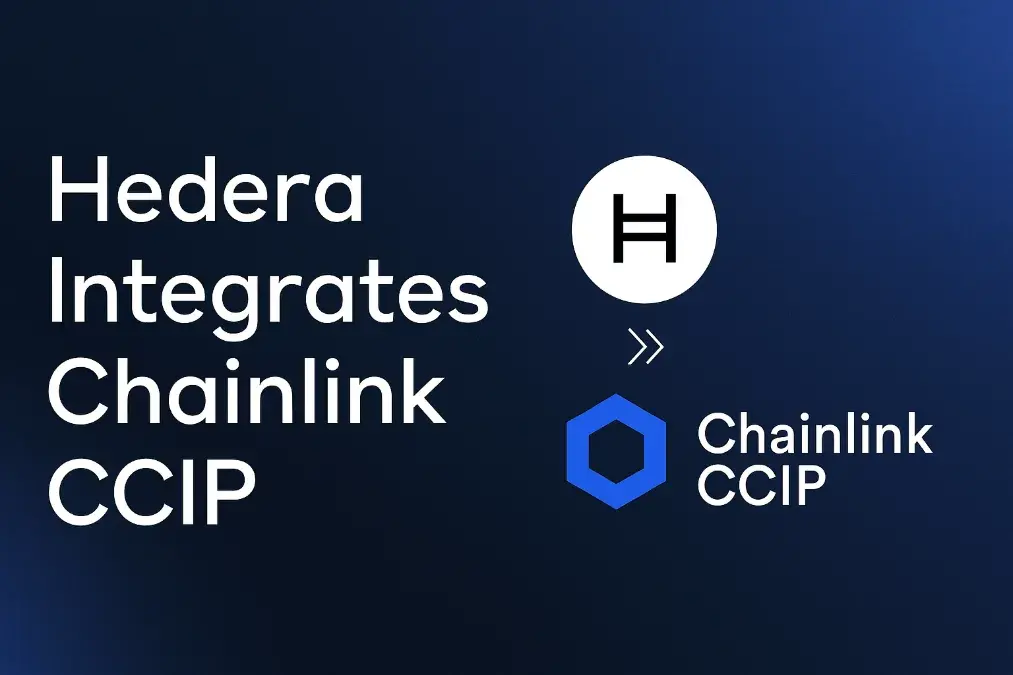Hedera Unleashes Cross-Chain Potential with Chainlink CCIP Integration

CryptoQuorum
Hedera has officially announced the integration of Chainlink’s Cross-Chain Interoperability Protocol (CCIP) into its mainnet. This landmark collaboration unlocks a new era of possibilities for the Hedera ecosystem, empowering developers to build sophisticated DeFi applications and tokenize real-world assets (RWAs) with unprecedented ease and security.
The integration of Chainlink CCIP marks a pivotal moment for Hedera, a high-performance, open-source, leaderless proof-of-stake network designed for enterprise-grade applications. By leveraging Chainlink’s industry-leading interoperability standard, Hedera now gains native connectivity to over 46 other blockchain networks. This vast network of interconnected chains opens up a wealth of opportunities for asset transfer, data sharing, and the creation of novel cross-chain applications that were previously complex or even impossible to implement.
Chainlink CCIP: The Key to Unlocking Interoperability
Chainlink’s CCIP is a revolutionary protocol that provides a secure and reliable infrastructure for transferring data and value across different blockchain ecosystems. Unlike earlier bridging solutions that often suffered from security vulnerabilities and fragmented liquidity, CCIP is built with a strong emphasis on security and resilience. It utilizes a decentralized network of oracles to verify cross-chain transactions, ensuring their integrity and preventing malicious activities.
The core components of Chainlink CCIP include:
- Decentralized Oracle Networks (DONs): These networks consist of independent, Sybil-resistant nodes that provide off-chain data and computation to smart contracts. CCIP leverages the robust security and reliability of Chainlink’s existing oracle infrastructure.
- Anti-Fraud Network: This dedicated network monitors cross-chain transfers for suspicious activity, adding an extra layer of security and alerting users and protocols to potential risks.
- Programmable Token Bridges: CCIP enables the secure and efficient transfer of various digital assets, including fungible tokens (like stablecoins and wrapped assets) and non-fungible tokens (NFTs), across connected blockchains.
- Smart Contract Interface: CCIP provides a user-friendly interface for developers to easily integrate cross-chain functionality into their decentralized applications (dApps).
The integration of these components into Hedera’s mainnet empowers developers to build truly interoperable applications that can access liquidity, data, and functionality across a multitude of blockchain environments.
Empowering DeFi Innovation on Hedera
The immediate impact of Chainlink CCIP integration is expected to be felt most significantly within the DeFi ecosystem on Hedera. By enabling seamless asset transfers and data sharing with other prominent DeFi platforms on networks like Ethereum, Polygon, Avalanche, and many others, Hedera can attract new liquidity and users to its burgeoning DeFi landscape.
Developers can now leverage CCIP to build innovative DeFi applications on Hedera that offer:
- Cross-Chain Lending and Borrowing: Users can collateralize assets on one blockchain and borrow assets on Hedera, or vice versa, opening up new avenues for capital efficiency.
- Cross-Chain Decentralized Exchanges (DEXs): CCIP facilitates the creation of DEXs that can aggregate liquidity from multiple blockchains, offering users deeper liquidity and reduced slippage.
- Yield Aggregation Across Chains: Protocols can be built to automatically allocate capital to the highest-yielding opportunities across different connected blockchains.
- Cross-Chain Stablecoin Transfers: Users can seamlessly move stablecoins between Hedera and other networks, facilitating arbitrage opportunities and cross-border payments.
The security and reliability of Chainlink’s oracle network underpin these cross-chain DeFi applications, providing users with greater confidence in the integrity of their transactions.
Tokenized Real-World Assets (RWAs): A New Frontier for Hedera
Beyond DeFi, the integration of Chainlink CCIP also unlocks significant potential for the tokenization of real-world assets (RWAs). RWAs, such as real estate, commodities, and intellectual property, can be represented as digital tokens on a blockchain, offering increased liquidity, fractional ownership, and greater accessibility.
CCIP enables the seamless transfer and utilization of these tokenized RWAs across different blockchain ecosystems. For example:
- Tokenized real estate could be used as collateral for loans on other DeFi platforms.
- Ownership of tokenized commodities could be easily transferred to users on different networks.
- Data related to tokenized assets could be securely shared with smart contracts on other blockchains for various applications.
This cross-chain interoperability is crucial for the widespread adoption of RWAs, as it allows these assets to participate in the broader DeFi ecosystem and unlock new forms of utility and value. Hedera’s focus on enterprise-grade scalability and security, combined with Chainlink’s robust interoperability solution, positions it as a compelling platform for the future of RWA tokenization.
Stablecoin Growth Amidst TVL Fluctuations
Interestingly, the announcement of Chainlink CCIP integration comes at a time when Hedera has experienced a drop in its total value locked (TVL). TVL is a key metric used to gauge the overall health and activity of a DeFi ecosystem, representing the total value of assets locked within its smart contracts. While a decrease in TVL might raise concerns, it’s important to consider other factors at play.
Despite the TVL dip, the stablecoin volume on the Hedera network has reportedly grown substantially in 2025. This suggests that while the overall amount of locked assets might have decreased, the transactional activity involving stablecoins – a crucial component of any thriving DeFi ecosystem – has seen significant growth. This could indicate a shift in the types of applications being used on Hedera, with a greater focus on stablecoin-based transactions and payments.
The integration of Chainlink CCIP is expected to further fuel this growth in stablecoin usage by making it easier and more secure to transfer stablecoins between Hedera and other networks. This enhanced interoperability can attract more stablecoin liquidity to Hedera, further strengthening its DeFi ecosystem.
The Synergistic Power of Hedera and Chainlink
The collaboration between Hedera and Chainlink represents a powerful synergy between two leading players in the Web3 space. Hedera provides a high-performance and secure infrastructure for building decentralized applications, while Chainlink offers the industry-standard for secure and reliable off-chain data and cross-chain interoperability.
By combining their respective strengths, Hedera and Chainlink are paving the way for a more interconnected and efficient Web3 ecosystem. The integration of CCIP is not just a technological upgrade for Hedera; it is a strategic move that positions the network at the forefront of the cross-chain revolution, attracting developers, users, and liquidity from across the entire blockchain landscape. The long-term implications of this integration are vast, promising to unlock a new wave of innovation in DeFi, RWAs, and beyond.
The Hedera community is understandably enthusiastic about the possibilities that Chainlink CCIP brings. This integration validates Hedera’s commitment to fostering a vibrant and interconnected ecosystem. As developers begin to explore the potential of cross-chain applications on Hedera, we can expect to see a surge in innovation and the emergence of novel use cases that leverage the power of interoperability. The future of decentralized applications is increasingly cross-chain, and Hedera, powered by Chainlink CCIP, is now firmly positioned to be a key player in this evolving landscape.
Stay informed, read the latest crypto news in real time!
Conclusion: A Bold Step Towards an Interoperable Future
The integration of Chainlink’s CCIP protocol into Hedera’s mainnet is a significant milestone for both projects and the wider blockchain ecosystem. By enabling seamless interoperability with over 46 other blockchains, Hedera has unlocked a wealth of new possibilities for DeFi applications and the tokenization of real-world assets. While the network has experienced a recent dip in TVL, the substantial growth in stablecoin volume suggests a dynamic and evolving ecosystem.
The security and reliability of Chainlink’s oracle network provide a robust foundation for these cross-chain endeavors, instilling confidence in developers and users alike. This collaboration underscores the growing recognition of interoperability as a crucial element for the mainstream adoption of Web3 technologies. As developers begin to build and deploy cross-chain applications on Hedera, we can anticipate a vibrant and interconnected future where value and data can flow seamlessly across different blockchain networks. Hedera’s bold step into the realm of cross-chain interoperability, powered by Chainlink, signals a new era of growth and innovation for the network and the broader decentralized landscape.




